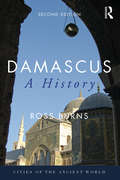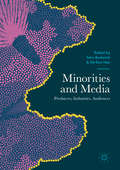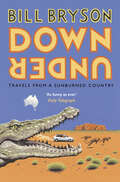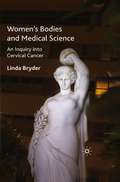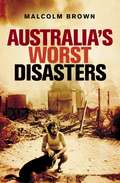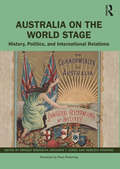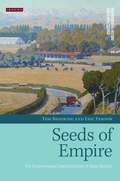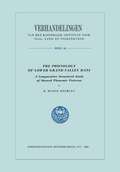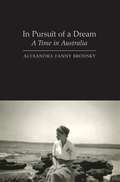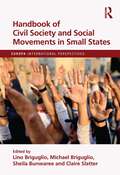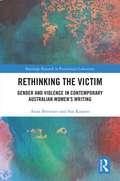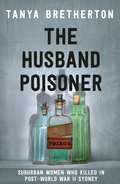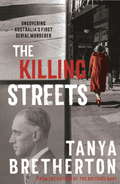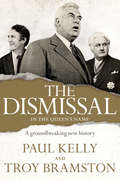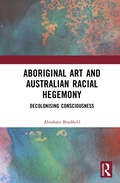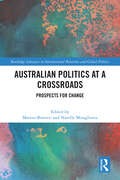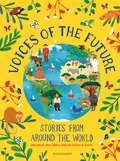- Table View
- List View
Damascus: A History (Cities of the Ancient World)
by Ross BurnsDamascus, first published in 2005, was the first account in English of the history of the city, bringing out the crucial role it has played at many points in the region’s past. It traces the story of this colourful, significant and complex city through its physical development, from the its emergence in around 7000 BC through the changing cavalcade of Aramaean, Persian, Greek, Roman, Byzantine, Arab, Turkish and French rulers to independence in 1946. This new edition has been thoroughly updated using recent scholarship and includes an additional chapter placing the events of the Syrian post-2011 conflict in the context of the city’s tumultuous experiences over the last century. This volume is a must-read for anyone interested in the sweep of Syrian history and archaeology, and is an ideal partner to Burns’ Aleppo (2016). Lavishly illustrated, Damascus: A History remains a unique and compelling exploration of this fascinating city.
Damascus: A History (Cities of the Ancient World)
by Ross BurnsDamascus, first published in 2005, was the first account in English of the history of the city, bringing out the crucial role it has played at many points in the region’s past. It traces the story of this colourful, significant and complex city through its physical development, from the its emergence in around 7000 BC through the changing cavalcade of Aramaean, Persian, Greek, Roman, Byzantine, Arab, Turkish and French rulers to independence in 1946. This new edition has been thoroughly updated using recent scholarship and includes an additional chapter placing the events of the Syrian post-2011 conflict in the context of the city’s tumultuous experiences over the last century. This volume is a must-read for anyone interested in the sweep of Syrian history and archaeology, and is an ideal partner to Burns’ Aleppo (2016). Lavishly illustrated, Damascus: A History remains a unique and compelling exploration of this fascinating city.
Australia & Israel: A Diasporic, Cultural and Political Relationship
by Burla, Shahar; Lawrence, DashielAustralia and the State of Israel have maintained a cordial if at times ambiguous relationship. The two countries are geographically isolated: strategic, economic and cultural interests lie increasingly with Asia for one, and with the US and the EU for the other. But for all that divides the two states, there is also much they share. Australia played an important role in the Jewish state's establishment in 1948, and is home to the most Zionist centered Jewish diaspora globally. Jewishness for most Australian Jews has been shaped and defined by engagement with and support for Israel. At the heart of this engagement is a small but thriving Israeli community within the larger multicultural Australia. Australia and Israel: A Diasporic, Cultural and Political relationship draws attention to the important historical and contemporary nexus between this diaspora and its imagined homeland. The collection also considers the ways in which these two states mobilise national myths and share environmental challenges. In recent time relations between the two states have been tested by the illegal use of Australian passports in 2010, the mysterious death of dual national Ben Zygier, and growing disquiet within the ranks of the Australian Labor Party and the Australian Greens over Israel's handling of the Israel-Palestinian conflict. One prominent world-wide issue is the Palestinian BDS (Boycotts, Divestments and Sanctions) movement, which has attracted sympathy and support that has brought about substantive differences of opinion regarding its legitimacy within the Jewish Australian community. These issues demonstrate the multifaceted and complex picture of two very different nations, that nevertheless share an abiding connection.
Minorities and Media: Producers, Industries, Audiences
by John Budarick Gil-Soo HanThis book examines the relationships between ethnic and Indigenous minorities and the media in Australia. The book places the voices of minorities at its centre, moving beyond a study of only representation and engaging with minority media producers, industries and audiences. Drawing on a diverse range of studies – from the Indigenous media environment to grassroots production by young refugees – the chapters within engage with the full range of media experiences and practices of marginalized Australians. Importantly, the book expands beyond the victimization of Indigenous and ethnic minorities at the hands of mainstream media, and also analyses the empowerment of communities who use media to respond to, challenge and negotiate social inequalities.
Down Under: Travels in a Sunburned Country (Bryson #6)
by Bill BrysonIt is the driest, flattest, hottest, most desiccated, infertile and climatically aggressive of all the inhabited continents and still Australia teems with life – a large portion of it quite deadly. In fact, Australia has more things that can kill you in a very nasty way than anywhere else.Ignoring such dangers – and yet curiously obsessed by them – Bill Bryson journeyed to Australia and promptly fell in love with the country. And who can blame him? The people are cheerful, extrovert, quick-witted and unfailingly obliging: their cities are safe and clean and nearly always built on water; the food is excellent; the beer is cold and the sun nearly always shines. Life doesn’t get much better than this…
Women's Bodies and Medical Science: An Inquiry into Cervical Cancer (Science, Technology and Medicine in Modern History)
by L. BryderAn analysis of a scandal involving a doctor accused of allowing a number of women to develop cervical cancer from carcinoma in situ as part of an experiment he had been conducting since the 1960s into conservative treatment of the disease, to more broadly explore dramatic changes in medical history in the second half of the twentieth century.
Australia's Worst Disasters
by Malcolm BrownGraphic accounts of Australia’s worst disasters – historical as well as events of recent years.From the Ash Wednesday bushfires of 1983 to the implosion of the Royal Canberra Hospital in 1997, and from the shocking Granville railway crash in 1977 to the Sea King helicopter crash of 2005, Australia's history has been punctuated by incidents of disaster and tragedy that have shocked us all. Sometimes warning signs were not read (or were ignored); sometimes human error was to blame. These graphic and compelling accounts by veteran Sydney Morning Herald journalist Malcolm Brown and other award-winning journalists tell us far more than simply what happened - they provide unique insights into the impact of these events on the lives of innocent people. And, interspersed with stories of death and destruction, are heart-warming accounts of courage, grace and just plain good luck.
Australia on the World Stage: History, Politics, and International Relations
by Bridget Brooklyn Benjamin T. Jones Rebecca StratingAustralia on the World Stage: History, Politics, and International Relations offers a fresh examination of Australia’s past and present. From the complex interactions of First Nations to modern international relations with significant partners and allies, it examines the forces that have influenced the place now called Australia both historically and today. It is a unique history told in two parts. The first half of the book examines the way Australia acted on the world stage both before and after British colonisation. It outlines the evolution of Australia’s relationship with the United Kingdom, first as colonies, then a dominion, and finally as an independent nation. It finishes with a First Nations perspective on foreign relations. The second half of the book provides a wide-ranging history of Australia’s dealings with major powers, the United States and China, as well as its relationships with New Zealand, Aotearoa, the Pacific Islands, Indonesia, Japan, Antarctica, and the United Nations. Written by leading and emerging researchers in their fields, this book encourages the reader to consider Australia’s performance on the world stage over the longue durée, well before the word ‘Australia’ was ever dreamt up. This interdisciplinary work challenges lazy stereotypes that see Australia's international history as fixed and uncontested. In revisiting Australia’s foreign relations, this work also asks the reader to consider its future directions.
Australia on the World Stage: History, Politics, and International Relations
by Bridget Brooklyn Benjamin T. Jones Rebecca StratingAustralia on the World Stage: History, Politics, and International Relations offers a fresh examination of Australia’s past and present. From the complex interactions of First Nations to modern international relations with significant partners and allies, it examines the forces that have influenced the place now called Australia both historically and today. It is a unique history told in two parts. The first half of the book examines the way Australia acted on the world stage both before and after British colonisation. It outlines the evolution of Australia’s relationship with the United Kingdom, first as colonies, then a dominion, and finally as an independent nation. It finishes with a First Nations perspective on foreign relations. The second half of the book provides a wide-ranging history of Australia’s dealings with major powers, the United States and China, as well as its relationships with New Zealand, Aotearoa, the Pacific Islands, Indonesia, Japan, Antarctica, and the United Nations. Written by leading and emerging researchers in their fields, this book encourages the reader to consider Australia’s performance on the world stage over the longue durée, well before the word ‘Australia’ was ever dreamt up. This interdisciplinary work challenges lazy stereotypes that see Australia's international history as fixed and uncontested. In revisiting Australia’s foreign relations, this work also asks the reader to consider its future directions.
Seeds of Empire: The Environmental Transformation of New Zealand (Environmental History and Global Change)
by Tom Brooking Eric PawsonThe traditional image of New Zealand is one of verdant landscapes with sheep grazing on lush green pastures. Indeed, as far back as the nineteenth century, promotional literature declared its soils to be rich, its weather invariably benign; whilst artists' paintings bathed it in an almost subtropical glow. Such representations, however, were at best partial, at worst unrealistic, for this landscape is almost entirely an artificial creation.The transformation of the New Zealand landscape took place as Britain became increasingly reliant on its overseas territories for supplies of food and raw material. All over the Empire indigenous plants were replaced with 'English grasses', to provide the worked up products of pasture - meat, butter, cheese, wool and hides. These 'seeds of empire' were in the vanguard of colonial development and in New Zealand this process was carried to an extreme as swamps were drained and hundreds of thousands of hectares of rain forest were burnt and re-seeded with imported grasses. Seeds of Empire provides an innovative and challenging look at the impact of this European settlement and development of New Zealand's landscape and environment. In exploring how, why and with what consequences New Zealand was transformed into these 'empires of grass' the authors provide not just an exciting reappraisal of New Zealand's environmental history but a long overdue exploration of the significance of grass in the processes of sowing empire.
The Phonology of Lower Grand Valley Dani: A Comparative Structural Study of Skewed Phonemic Patterns (Verhandelingen van het Koninklijk Instituut voor Taal-, Land- en Volkenkunde)
by H. Myron BromleyIn Pursuit of a Dream: A Time in Australia
by Alexandra Fanny BrodskyA vibrant and moving memoir of life in Australia and Europe in the middle of the twentieth century.In Pursuit of a Dream begins with a brief portrait of the author's family circumstances after the Second World War, when they were finally reunited after being forced into hiding to escape the Gestapo. This appealing personal history combines autobiography with a picture of the international situation in the middle of the twentieth century. After some time spent visiting friends and family in war-torn France and Belgium, the author and her parents obtained passes to join her brother in Australia on a journey which was to change her life completely. Through her eyes we experience the sea voyage and Sydney life in the 1940s and gain an original perspective on Australia during this period. Her vivid descriptions clearly convey the impact of post-war migration, and the story of her subsequent return to Europe and later marriage to the Australian scientist, Henry Harris, make this a most attractive and authentic cultural history.
Handbook of Civil Society and Social Movements in Small States (Europa International Perspectives)
by Lino Briguglio Claire Slatter Michael Briguglio Sheila BunwareeThis volume is unique because of its focus on small states. There are many studies on civil society and social movements, but none that specifically deal with this category of countries. As is well known, small states have particular characteristics, including a limited ability to reap the benefits of economies of scale, a high degree of exposure to forces outside their control, and the proximity of politicians to the voters, often leading to clientelistic relationships and patronage networks. The small island developing states have the additional problem of high environmental vulnerability, with some also dealing with disproportionate ecological footprints. These factors have a bearing on the organization and performance of civil society organizations and social movements, as explained in several chapters of this book. The volume is organized in three parts, dealing with aspects of civil society and social moments in small states in the political, social and environmental spheres, respectively. Various definitions of civil society are proposed in the chapters, but most authors associate the term with organized groups, operating in the interest of citizens, independently of government and commercial business, including various forms of non-governmental organizations (NGOs). Civil society also encompasses social movements, which are considered to be loosely organized collective campaigns in pursuit of social goals. These two terms are sometimes used interchangeably; however, some authors argue that social movements tend to engage in ‘contentious politics’ including protests, while NGOs engage through more organized and institutional routes.
Handbook of Civil Society and Social Movements in Small States (Europa International Perspectives)
by Lino Briguglio Claire Slatter Michael Briguglio Sheila BunwareeThis volume is unique because of its focus on small states. There are many studies on civil society and social movements, but none that specifically deal with this category of countries. As is well known, small states have particular characteristics, including a limited ability to reap the benefits of economies of scale, a high degree of exposure to forces outside their control, and the proximity of politicians to the voters, often leading to clientelistic relationships and patronage networks. The small island developing states have the additional problem of high environmental vulnerability, with some also dealing with disproportionate ecological footprints. These factors have a bearing on the organization and performance of civil society organizations and social movements, as explained in several chapters of this book. The volume is organized in three parts, dealing with aspects of civil society and social moments in small states in the political, social and environmental spheres, respectively. Various definitions of civil society are proposed in the chapters, but most authors associate the term with organized groups, operating in the interest of citizens, independently of government and commercial business, including various forms of non-governmental organizations (NGOs). Civil society also encompasses social movements, which are considered to be loosely organized collective campaigns in pursuit of social goals. These two terms are sometimes used interchangeably; however, some authors argue that social movements tend to engage in ‘contentious politics’ including protests, while NGOs engage through more organized and institutional routes.
Rethinking the Victim: Gender and Violence in Contemporary Australian Women's Writing (Routledge Research in Postcolonial Literatures)
by Anne Brewster Sue KossewThis book is the first to examine gender and violence in Australian literature. It argues that literary texts by Australian women writers offer unique ways of understanding the social problem of gendered violence, bringing this often private and suppressed issue into the public sphere. It draws on the international field of violence studies to investigate how Australian women writers challenge the victim paradigm and figure women’s agencies. In doing so, it provides a theoretical context for the increasing number of contemporary literary works by Australian women writers that directly address gendered violence, an issue that has taken on urgent social and political currency. By analysing Australian women’s literary representations of gendered violence, this book rethinks victimhood and agency, particularly from a feminist perspective. One of its major innovations is that it examines mainstream Australian women’s writing alongside that of Indigenous and minoritised women. In doing so it provides insights into the interconnectedness of Australia’s diverse settler, Indigenous and diasporic histories in chapters that examine intimate partner violence, violence against Indigenous women and girls, family violence and violence against children, and the war and political violence.
Rethinking the Victim: Gender and Violence in Contemporary Australian Women's Writing (Routledge Research in Postcolonial Literatures)
by Anne Brewster Sue KossewThis book is the first to examine gender and violence in Australian literature. It argues that literary texts by Australian women writers offer unique ways of understanding the social problem of gendered violence, bringing this often private and suppressed issue into the public sphere. It draws on the international field of violence studies to investigate how Australian women writers challenge the victim paradigm and figure women’s agencies. In doing so, it provides a theoretical context for the increasing number of contemporary literary works by Australian women writers that directly address gendered violence, an issue that has taken on urgent social and political currency. By analysing Australian women’s literary representations of gendered violence, this book rethinks victimhood and agency, particularly from a feminist perspective. One of its major innovations is that it examines mainstream Australian women’s writing alongside that of Indigenous and minoritised women. In doing so it provides insights into the interconnectedness of Australia’s diverse settler, Indigenous and diasporic histories in chapters that examine intimate partner violence, violence against Indigenous women and girls, family violence and violence against children, and the war and political violence.
The Husband Poisoner: Suburban women who killed in post-World War II Sydney
by Tanya BrethertonShocking real-life stories of murderous women who used rat poison to rid themselves of husbands and other inconvenient family members. For readers of compelling history and true crime, from critically acclaimed, award-winning author Tanya Bretherton.After World War II, Sydney experienced a crime wave that was chillingly calculated. Discontent mixed with despair, greed with callous disregard. Women who had lost their wartime freedoms headed back into the kitchen with sinister intent and the household poison thallium, normally used to kill rats, was repurposed to kill husbands and other inconvenient family members. Yvonne Fletcher disposed of two husbands. Caroline Grills cheerfully poisoned her stepmother, a family friend, her brother and his wife. Unlike arsenic or cyanide, thallium is colourless, odourless and tasteless; victims were misdiagnosed as insane malingerers or ill due to other reasons. And once one death was attributed to natural causes, it was all too easy for an aggrieved woman to kill again.This is the story of a series of murders that struck at the very heart of domestic life. It's the tale of women who looked for deadly solutions to what they saw as impossible situations. The Husband Poisoner documents the reasons behind the choices these women made - and their terrible outcomes.
The Killing Streets: Uncovering Australia's first serial murderer (The Australian Crime Vault)
by Tanya BrethertonFrom the acclaimed author of The Suitcase Baby and The Suicide Bride, the story of a series of horrific murders that began in 1930s Sydney - and a killer who remained at large for over two decades.In December 1932, as the Depression tightened its grip, the body of a woman was found in Queens Park, Sydney. It was a popular park. There were houses in plain view. Yet this woman had been violently murdered without anyone noticing. Other equally brutal and shocking murders of women in public places were to follow. Australia's first serial killer was at large.Police failed to notice the similarities between the victims until the death of one young woman - an aspiring Olympic swimmer - made the whole city take notice. On scant evidence, the unassuming Eric Craig was arrested. But the killings didn't stop...This compelling story of a city crippled by fear and a failing economy, of a killer at large as panic abounds, is also the story of what happens when victims aren't perfect and neither are suspects, and when a rush to judgement replaces the call of reason.
The Dismissal: In the Queen's Name (PDF)
by Troy Bramston Paul KellyThere is no more dramatic event in our political history than the dismissal. This book is the definitive story, filled with fresh documents, revelations and new interviews that change our understanding of this event. It is also a brilliant forensic analysis of the ruthless, proud and stubborn main players - Malcolm Fraser, Gough Whitlam and Sir John Kerr. As keys to our understanding, Kelly and Bramston examine four central aspects of the dismissal- the real attitude of Buckingham Palace towards Kerr; whether Kerr tipped Fraser off about his plan; Kerr's deception of Whitlam; and Kerr's dealings with former High Court judges Sir Garfield Barwick and Sir Anthony Mason. In the gripping story that follows, the ambitions and flaws of Whitlam, Fraser and Kerr are laid bare as never before. Drawing on a range of new sources, some of which have never before been made public - including hundreds of pages from Kerr's archives - this remarkable account is dispassionate in its analysis, vivid in its narrative and brutal in its conclusions. It exposes the true motivations, the extent of the deceit and the scale of the collusion.
The Dismissal: In the Queen's Name
by Troy Bramston Paul KellyThere is no more dramatic event in our political history than the dismissal. This book is the definitive story, filled with fresh documents, revelations and new interviews that change our understanding of this event. It is also a brilliant forensic analysis of the ruthless, proud and stubborn main players - Malcolm Fraser, Gough Whitlam and Sir John Kerr. As keys to our understanding, Kelly and Bramston examine four central aspects of the dismissal- the real attitude of Buckingham Palace towards Kerr; whether Kerr tipped Fraser off about his plan; Kerr's deception of Whitlam; and Kerr's dealings with former High Court judges Sir Garfield Barwick and Sir Anthony Mason. In the gripping story that follows, the ambitions and flaws of Whitlam, Fraser and Kerr are laid bare as never before. Drawing on a range of new sources, some of which have never before been made public - including hundreds of pages from Kerr's archives - this remarkable account is dispassionate in its analysis, vivid in its narrative and brutal in its conclusions. It exposes the true motivations, the extent of the deceit and the scale of the collusion.
Aboriginal Art and Australian Racial Hegemony: Decolonising Consciousness
by Abraham BradfieldThis book explores the complexities of Indigenous and non-Indigenous relations in contemporary Australia. It unpacks the continuation of a pervasive colonial consciousness within settler-colonial settings, but also provokes readers to confront their own habits of thought and action. Through presenting a reflexive narrative that draws on the author’s encounters with Indigenous artists and their artwork, knowledge, stories, and lived experiences, this provocative and insightful work encourages readers to consider what decolonising means to them. It presents a compelling and relevant argument that calls for a reorientation of dominant discourses fixed within Eurocentric frameworks, whilst also addressing the deep complexities and challenges of living within intercultural settler-colonial settings where different views and perspectives clash and complement one another.
Aboriginal Art and Australian Racial Hegemony: Decolonising Consciousness
by Abraham BradfieldThis book explores the complexities of Indigenous and non-Indigenous relations in contemporary Australia. It unpacks the continuation of a pervasive colonial consciousness within settler-colonial settings, but also provokes readers to confront their own habits of thought and action. Through presenting a reflexive narrative that draws on the author’s encounters with Indigenous artists and their artwork, knowledge, stories, and lived experiences, this provocative and insightful work encourages readers to consider what decolonising means to them. It presents a compelling and relevant argument that calls for a reorientation of dominant discourses fixed within Eurocentric frameworks, whilst also addressing the deep complexities and challenges of living within intercultural settler-colonial settings where different views and perspectives clash and complement one another.
Australian Politics at a Crossroads: Prospects for Change (ISSN)
by Matteo Bonotti Narelle MiragliottaAs the 21st century proceeds apace, Australia faces new and old challenges, both domestically and internationally. These include managing complex governance issues, preventing democratic fracture, balancing an ever- shifting geopolitical strategic order, addressing the recognition and identity demands of marginalised groups, and responding to crises and urgent policy challenges, such as climate change.Bonotti, Miragliotta, and the other contributors to this volume analyse and evaluate the challenges which confront Australia by locating them in their national and comparative context. The various contributions reveal that while these challenges are neither novel nor unique to Australia, the way in which they manifest and Australia’s responses to them are shaped by the country’s distinctive history, culture, geography, location, and size.The chapters offer a cutting- edge analysis of these pressing challenges faced by Australia and offer reflections on how to address them. The book is a valuable resource for scholars and students of Australian politics, and of comparative politics in a global perspective.
Voices of the Future: Stories from Around the World
by Irina BokovaA wonderful anthology of eight stories addressing children's rights and sustainable development, written by child authors from all around the world and produced in conjunction with UNESCO's Voices of Future Generations initiative.UNESCO's Voices of Future Generations initiative works to empower children all around the world. The stories in this book are written by children aged between 8 and 12 from every corner of the globe: Canada, Mexico, Papua New Guinea, Samoa, South Africa, Taiwan, Uruguay and United Arab Emirates. With beautiful, full colour illustrations throughout by four talented illustrators, Jhonny Nunez, Giovana Medeiros, Marco Guadalupi and Mona Meslier Menaua, this book is the perfect way to engage children with the issues facing the planet and the lives of children in other countries.The children's stories are imaginative, empowering and inspiring. They focus on the UN Convention on the Rights of the Child and the Sustainable Development Goals and present likeable characters who go on problem-solving adventures to fix the problems faced in each region. The book features a foreword by Irina Bokova, Director General of UNESCO.'... and together, the children could build a better future.'Book band: Dark Blue
